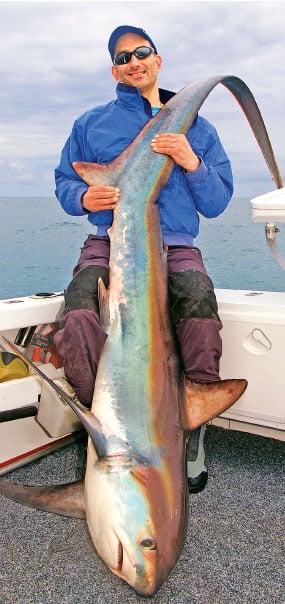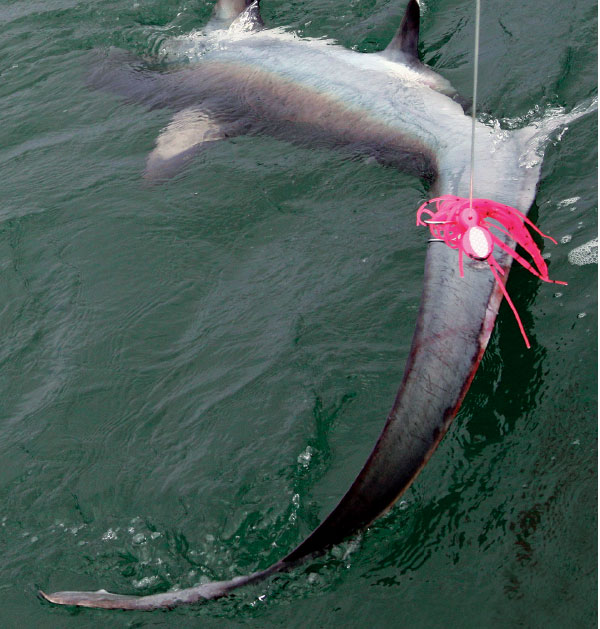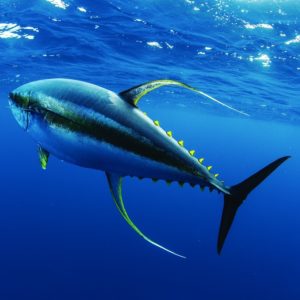
cali thresher sharks

| |The common thresher grows the heaviest of the three thresher species, which also include bigeye and pelagic. California’s state record is 575 pounds. GEOFF WILSON|
Spring is a time of plenty. Shoals of anchovies and sardines mill in the rich waters as warming temperatures attract migrants, including threshers sharks — some adults exceeding 300 pounds. The California state record is 575 pounds. “There’s evidence that female threshers come in to spawn,” says Milton Love, Ph.D., a professor of marine biology at the California State University at Santa Barbara, who theorizes about the reasons.
The Southern California Bight, a coastal crescent formed by Point Conception to the north and Point Loma to the south, is relatively void of other large predators. “That makes it safe for the females to come in and pup,” says Love.
Water temperature is also a key component. “Threshers start showing up in April and May when the water temperature climbs to the mid-60s,” he says. Yet, once the water reaches the high 60s or low 70s, the big threshers leave, though some believe the pups hang out for two or three years or more.
The upper lobe of a thresher’s tail — comprising 50 percent of its overall body length — serves two purposes, first as a long, menacing arm to corral baitfish into a dense “meatball” as the shark spirals around a nervous school. The tail then transforms into a deadly whip as the thresher cleaves the compacted school into pieces, circling back to gorge at its leisure.
A thresher can stage a spectacular fight with uncanny speeds and leaps that leave it hanging in midair, a phenomenon known as butterflying. Threshers have it all, and you can fish for them with just about any kind of boat, including kayaks, using a variety of techniques. Let’s look at some.
‘Yak Attack
Coastal kayak fishing enjoys immense popularity in Southern California, and threshers offer these anglers a thrilling shot at big-game-style fishing. “I once had a thresher tow me five miles up the coast,” explains longtime kayak angler Jeff Krieger of Simi Valley. “I fought the fish for two hours before he broke off at color.” Krieger had a while to think about that thresher’s size during the return paddle. “It was around 350 pounds,” he estimates.
Krieger fishes for threshers from his Ocean Kayak Prowler Trident 15, targeting areas from Malibu up to Santa Barbara. An important part of his success is a network of kayak buddies that helps him zero in on the bite. “The network is important for kayakers,” he says, “because you can’t just start the engine and run if the bite’s 10 miles away.”
Depths ranging from just 20 feet at the edge of the kelp or surf line to depths of 120 feet or more are within range for Krieger and his kayak. “I use a fish finder on the kayak to find bait concentrations,” he says. Threshers don’t mind green water, and this is where Krieger says he often finds bait schools and, consequently, the sharks. “In these bait-rich areas, you might see the tail slaps or threshers crashing on bait at the surface,” he explains.
To find concentrations of threshers, Krieger trolls with a diving plug such as a Rapala CD-14 Mag in a sardine or mackerel pattern, paddling steadily to keep the lure effectively swimming. “I look at the rod tip,” he says, “and if it’s pulsating nicely, that tells me the lure is working well.”

| |Switching to whole or slabbed mackerel works well once you draw a thresher close with a hookless lure like a Rapala or Shark Killer with a mack pinned on via a modified snap.JIM HENDRICKS|
One of the major problems with such lures is that the threshers often foul-hook themselves when tail-swatting the offering. So once a concentration of threshers is found, kayak anglers such as Krieger will switch to natural baits.
Baiting Up
On a kayak, having fresh bait usually means catching it on the spot. Krieger uses a sabiki rig to jig up a few sardines or mackerel in the area, then quickly transfers one to a heavier outfit to slow-troll it. Live bait seems to work better for Krieger; the bait’s frantic vibrations attract more strikes than with a dead bait, he believes.
Once hooked from a kayak, a big thresher can tow the craft for miles. “Usually, you get pulled around for 10 or 15 minutes,” says Krieger, “and then the fish reverses direction and goes deep, circling under the kayak.” The fight is made more difficult by the inability to exert a lot of leverage.
Bringing even a small thresher beside a kayak is tricky, as the tail can wreak havoc and deliver a nasty whack. The key is to make sure the fish is tired and relatively docile before grabbing the leader to bring it beside the kayak. “I like to grab the shark by the tail,” says Krieger, “and then turn it over to put it in a catatonic state before removing the hook and releasing it.”
Run and Gun
Paul Hoofe of Costa Mesa considers thresher sharks one of the world’s greatest game fish, provided they are hooked in the mouth. Fishing from his 246 Shamrock, he targets this species heavily in spring along the coasts of Los Angeles and Orange counties, but confines his actual fishing to times when he is certain he has located an area that’s holding threshers. The rest of the time he’s on the hunt, motoring up or down the coast until he finds signs of life — birds and bait. The birds he eyeballs, sometimes with binoculars. The bait he locates with a fish finder.
“If you really want to catch threshers, you have to look for the schools of bait,” says Hoofe. “If there’s no food, you’ll have a hard time finding a thresher.” By the same token, once he finds a life zone or gets a strike — even if he doesn’t hook the fish — he stays put, refusing to leave fish to find fish.
Hoofe scales his tackle to the size of the fish, employing relatively heavy tackle when the big females come in to spawn. “But when the fish are smaller, I break out the ultralight tackle and have a blast catching and releasing the pups,” says Hoofe, an International Game Fish Association representative who holds three IGFA line-class records for the common thresher in 2-, 4- and 6-pound-test categories.
Not all of his line-class attempts meet with success. Before setting the current 6-pound-test line-class mark of 94 pounds, 12 ounces, Hoofe hooked a much heavier thresher — about 180 pounds — fighting the fish for 23 hours and 40 minutes before losing it the morning after he hooked it.
Deadly Downriggers
Coastal threshers feed throughout the water column, sometimes targeting forage in deeper water, particularly at the head of marine canyons close to the coast. Downrigger trolling offers a way to reach the fish when they’re deeper. Most downrigger fishing for threshers is with live bait, usually a live Pacific mackerel, mackerel jack (known locally as a Spanish mackerel) or sardine. Larger baits such as Pacific mackerel lend themselves to bridling, while smaller baits like sardines are hooked crosswise through the nose.
Using a downrigger on each side of the boat allows you to stagger the baits. The depth depends on where the bait schools are holding, as you want to place your baits at the same depth or just above the schools. Trolling speeds are usually around 2 knots or less. “Downrigger fishing is my favorite,” says Hoofe. “Once the baits are down, I watch the rods constantly. If I get a knockdown or the rod even twitches, I dump the reel into free-spool and stop the boat.”
Presumably at this stage, a thresher has batted at the bait and knocked the line out of the release clip, and the shark is now swinging around to devour its stunned prize. Free-spooling line and stopping the boat allows the bait to flutter away naturally. Hoofe uses non-offset circle hooks such as Lazer Sharp L2004EL Sea Guard Circle models, and this virtually eliminates the possibility of foul-hooking a thresher on the knockdown.
“You’ll know it worked if moments later line starts peeling off the reel,” Hoofe explains. To set the circle hook, he points the rod in the direction the line is going and, using a lever-drag reel, slowly increases drag pressure. This sets the circle hook in the corner of the shark’s mouth. Hoofe is a strong promoter of catch-and-release — and circle hooks help ensure that the threshers he releases survive.
Bait and Switch
Hoofe and his occasional fishing buddy Dave Elm, production manager for Santa Ana-based AFTCO, also use a bait-and-switch technique when they find fish feeding near the surface. They troll a hookless lure such as a pink Lead Masters’ Shark Killer (formerly Bait-O-Matic) with a mackerel pinned under the skirt or a black-and-purple Rapala CD-18 Mag at 3 knots about 75 yards back. At the same time, they troll a couple of skipbaits (with hooks) on the surface about 25 yards back. The goal is to attract the interest of a thresher with a hookless lure, and once that happens, the trolling stops and a crew member starts retrieving the lure.
“The thresher will keep attacking as you reel it closer to the boat,” Elm explains. “If the water is clear, you can actually watch the thresher follow the lure. Once the thresher’s within 25 yards, we let the lure sink away and hope the shark eats the skipbait as it drifts downward.” The skipbait can be either a whole dead mackerel hooked through the lower jaw and out through the nose or a mackerel slab hooked in through the skin side and out through the meat side.
“This type of fishing is very interactive,” says Hoofe. “When the fishing is hot, it’s not unusual to have a number of threshers attack the lures and baits in a single day of fishing.”
Now that’s an invasion force we can all welcome.

| |## Snag-and-Drag FiascoGiven the thresher’s penchant for attacking prey with a whack of its tail, a disproportionate number of fish are foul-hooked in the upper lobe of the caudal fin. Some anglers aim to foul-hook threshers by trolling plugs with multiple treble hooks — a dubious technique known as snag-and-drag. Not only does this violate angling ethics, snag-and-drag results in a high mortality rate. In many instances, the fish suffocates from being pulled backward in a protracted struggle. Yet even if the fish is released alive, 25 percent to 30 percent of the fish die later, according to an archival tagging study by the Oceanside-based nonprofit Pfleger Institute of Environmental Research (pier.org). Finally, from a purely fun point of view, anglers who tail-snag have no opportunity to enjoy the thresher’s spectacular aerial displays. A foul-hooked fish doesn’t jump. As thresher angler and IGFA representative Paul Hoofe puts it, “Once you hook a thresher in the mouth, you’ll never want to tail-hook one again.”BILL BOYCE / BOYCEIMAGE.COM|
Thresher Tackle
Tackle used for thresher fishing by Dave Elm and Paul Hoofe varies depending on the size of the fish they expect to hook.
Reels, Rods and Line
• For 50- to 150-pound threshers, Elm likes 20- to 30-pound-test monofilament loaded on a reel such as a Penn International 30 or Shimano Tiagra 30A with a 7-foot medium-action rod like a Calstar Grafighter 700L with AFTCO Lightweight Roller Guides.
• For 150- to 350-pound threshers, Hoofe prefers 50-pound mono on a Penn International 50 mounted to a Calstar 655XH 6½-foot rod.
• For targeting pups on ultralight lines (2- to 8-pound-test), Hoofe likes a Penn Squall 30LD or Shimano TLD 5 on a 6-foot light-action rod with AFTCO Lightweight Roller Guides.
• Terminal Tackle
• Hoofe insists on using a non-offset circle hook such as an Eagle Claw Lazer Sharp L2004EL Sea Guard Circle (in sizes 4/0 to 8/0, matched to the size of the bait) to all but eliminate foul-hooking.
• The leader setup used by Elm and Hoofe for threshers includes 10 to 12 feet of 80- to 125-pound mono connected to the main line with a barrel swivel. Then, 14 to 18 inches of single-strand, 100-pound-test, coffee-colored wire is connected via a barrel swivel using haywire twists for the swivel and hook.







